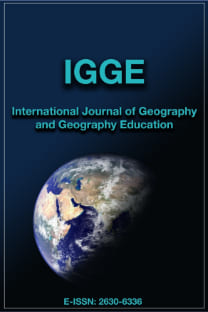Alan eğitiminde Web 2.0 uygulamalarının coğrafya dersi bağlamında değerlendirilmesi
Web 2.0, Eğitimde Web 2.0 Uygulamaları, Alan Eğitimi, Coğrafya Eğitimi, Öğretmenler, Coğrafya Öğretmenleri
Evaluation of Web 2.0 applications in field training in the context of geography course
Web 2.0, Web 2.0 Applications in Education, Field Education, Geography Education, Teachers, Geography Teachers,
___
- Adcock, L., & Bolick, C. (2011). Web 2.0 tools and the evolving pedagogy of teacher education. Contemporary issues in technology and teacher education, 11(2), 223-236.
- Ajjan, H., & Hartshorne, R. (2008). Investigating faculty decisions to adopt Web 2.0 technologies: Theory and empirical tests. The internet and higher education, 11(2), 71-80. https://doi.org/10.1016/j.iheduc.2008.05.002
- Alan, P. (2017). The impact of technology on geography and geography teachers. In M. Jones & D. Lambert (Ed.), Debates in Geography Education (pp. 184-196). Routledge.
- Biswas, S. (2023). ChatGPT and the future of medical writing. Radiology, 307(2), e223312.
- Chan, T. A. C. H., Ho, J. M.-B., & Tom, M. (2023). Miro: Promoting Collaboration through Online Whiteboard Interaction. RELC Journal, 00336882231165061. https://doi.org/10.1177/00336882231165061
- Chang, C.-H., & Wu, B. S. (2018). Teaching geography with technology—A critical commentary. In C.-H. Chang, B. S. Wu, T. Seow, & K. Irvine (Ed.), Learning geography beyond the traditional classroom: Examples from Peninsular Southeast Asia (pp. 35-47). Springer.
- Chen, M., Lin, H., Hu, M., He, L., & Zhang, C. (2013). Real-geographic-scenario-based virtual social environments: İntegrating geography with social research. Environment and Planning B: Planning and Design, 40(6), 1103-1121. https://doi.org/10.1068/b381
- Çelebi, C., & Satırlı, H. (2021). Web 2.0 araçlarının ilkokul seviyesinde kullanım alanları. Instructional Technology and Lifelong Learning, 2(1), 75-110. https://doi.org/10.52911/itall.938122
- Çelik, T. (2021). Web 2.0 araçları kullanımı yetkinliği ölçeği geliştirme çalışması. Pamukkale Üniversitesi Eğitim Fakültesi Dergisi, 449-478. https://doi.org/10.9779.pauefd.700181
- Çenesiz, M., & Özdemir, M. A. (2021). Web 2.0 araçlarının ortaöğretim 10. Sınıf coğrafya dersi topoğrafya ve kayaçlar konusunda akademik başarıya etkisi. lnternational Journal of Geography and Geography Education, 43, 39-53. https://doi.org/10.32003/igge.750323
- Elmas, R., & Geban, Ö. (2012). 21. Yüzyıl öğretmenleri için web 2.0 araçları. International Online Journal of Educational Sciences, 4(1), 243-254.
- Exarchou, E., Klonari, A., & Lambrinos, N. (2015). Using a social web 2.0 tool in geography and environmental research project: A content analysis of Greek high school students’ learning exchanges. Review of International Geographical Education Online, 5(1), 42-55.
- Gilbert, I. (2010). Why do I need a teacher when I’ve got Google?: The essential guide to the big issues for every 21st century teacher. Routledge London.
- Grosseck, G. (2009). To use or not to use web 2.0 in higher education? Procedia-Social and Behavioral Sciences, 1(1), 478-482. https://doi.org/10.1016/j.sbspro.2009.01.087
- Huang, K. H. (2011). A GIS-interface web site: Exploratory learning for geography curriculum. Journal of Geography, 110(4), 158-165.
- Hursen, C. (2021). The effect of problem-based learning method supported by web 2.0 tools on academic achievement and critical thinking skills in teacher education. Technology, Knowledge and Learning, 26, 515- 533. https://doi.org/10.1007/s10758-020-09458-2
- Kam, H.-J., & Katerattanakul, P. (2014). Structural model of team-based learning using Web 2.0 collaborative software. Computers & Education, 76, 1-12.
- Konstantinidis, A., Theodosiadou, D., & Pappos, C. (2013). Web 2.0 tools for supporting teaching. Turkish Online Journal of Distance Education, 14(4), 287-295.
- Kutlu-Demir, Ö. (2018). 21st century learning: Integration of web 2. 0 tools in Turkish adult language classrooms. (PhD Thesis, Social Science Institute, English Language Education).
- Leh, F. C., Anduroh, A., & Huda, M. (2021). Level of knowledge, skills and attitude of trainee teachers on web 2.0 applications in teaching geography in Malaysia schools. Heliyon, 7(12), e08568. https://doi.org/10.1016/j.heliyon.2021.e08568
- Liu, S.-H. (2011). Factors related to pedagogical beliefs of teachers and technology integration. Computers & Education, 56(4), 1012-1022. https://doi.org/10.1016/j.compedu.2010.12.001
- Lu, J., Lai, M., & Law, N. (2010). Knowledge building in society 2.0: Challenges and opportunities. In M. S. Khine & I. M. Saleh (Ed.), New science of learning: Cognition, computers and collaboration in education (pp. 553-567). Springer.
- Majid, N. A. A. (2014). Integration of Web 2.0 Tools in learning a programming course. Turkish Online Journal of Educational Technology-TOJET, 13(4), 88-94.
- Parkinson, A. (2013). How has technology impacted on the teaching of geography and geography teachers? In D. Lambert & M. S. Jones (Ed.), Debates in geography education (pp. 193-205). Routledge.
- Rizou, O., & Klonari, A. (2020). Using Web 2.0 tools in teaching spatial statistics: Secondary teachers’ views from Greece. In Smart Geography: 100 Years of the Bulgarian Geographical Society (pp. 55-63). Springer.
- Sendag, S., Osman, E., Sezgin, S., & Dulkadir, N. (2015). Preservice teachers’ critical thinking dispositions and web 2.0 competencies. Contemporary Educational Technology, 6(3), 172-187.
- Shank, P. (2008). Web 2.0 and beyond: The changing needs of learners, new tools, and ways to learn. In S. Carlıner & P. Shank (Ed.), The e-learning handbook (pp. 241-278).
- Tatlı, Z., Akbulut, H. İ., & Altınışık, D. (2016). Öğretmen adaylarının teknolojik pedagojik alan bilgisi özgüvenlerine web 2.0 araçlarının etkisi. Turkish Journal of Computer and Mathematics Education, 7(3), 659. https://doi.org/10.16949/turkbilmat.277878
- Tatli, Z., Akbulut, H. İ., & Altinisik, D. (2019). Changing attitudes towards educational technology usage in classroom: Web 2.0 tools. Malaysian Online Journal of Educational Technology, 7(2), 1-19. http://dx.doi.org/10.17220/mojet.2019.02.001
- Ünlü, M. (2014). Coğrafya öğretimi. Pegem Akademi Ankara.
- Vartanian, T. P. (2010). Secondary data analysis. New York: Oxford University Press.
- Wang, A. I., & Tahir, R. (2020). The effect of using Kahoot! For learning–A literature review. Computers & Education, 149, 103818. https://doi.org/10.1016/j.compedu.2020.103818
- Yıldırım, S., & Ünlü, M. (2021). Evaluating in-service GIS training for geography teachers based on G-TPACK model. International Journal of Geography and Geography Education (IGGE), 44, 112-123. https://doi.org/10.32003/igge.958881
- Young, M., & Muller, J. (2010). Three educational scenarios for the future: Lessons from the sociology of knowledge. European journal of education, 45(1), 11-27. https://doi.org/10.1111/j.1465-3435.2009.01413.x
- Yayın Aralığı: Yılda 3 Sayı
- Başlangıç: 1996
- Yayıncı: Marmara Üniversitesi
Erkan DÜNDAR, Ülkü Eser ÜNALDI
Sosyal bilgiler ders kitaplarındaki coğrafi öğelerin yerel ve küresel bağlamda incelenmesi
Romanya’da tarım sektörü ve arazi mülkiyet durumu (1990-2020).
Halk kültüründe ekmek: Karahöyük Ekmeği (Denizli)
Coğrafya öğretmen adaylarının arazi çalışmalarına hazırlık aşamalarının değerlendirilmesi
